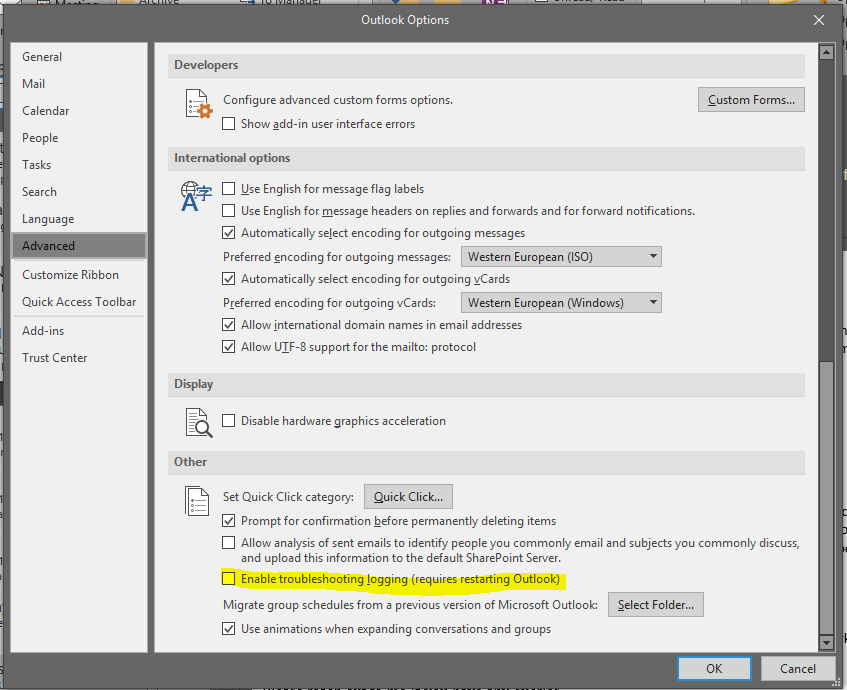Unable to see “free/busy” for cross forest Exchange server organizations
Recently worked on an issue Freebusy not viewable for a cross-forest setup
Let’s consider we have 2 forest
- Forest A
- Forest B
Forest A consists of Exchange 2013 and forest B consists of Exchange 2010
When a user from forest A looks up the FB of a User B he is not is not able to get the FB data instead he gets the below error
“No information. No free/busy information could be retrieved. Your server location could not be determined. Contact your administrator.”

When a user from Forest B looks up the FB they are able to see the FB of forest A
We found that the customer was using federation to look up the FB of the other forest, How?
By running Get-OrganizationRelationship forestB | FL I was able to find the below
RunspaceId : fb9d6166-28ae-4f06-8d3a-87eabc4a06c4
DomainNames : {ForestB.net}
FreeBusyAccessEnabled : True
FreeBusyAccessLevel : LimitedDetails
FreeBusyAccessScope :
MailboxMoveEnabled : False
DeliveryReportEnabled : False
MailTipsAccessEnabled : False
MailTipsAccessLevel : None
MailTipsAccessScope :
PhotosEnabled : False
TargetApplicationUri : FYDIBOHF25SPDLT.ForestB.net
TargetSharingEpr :
TargetOwaURL :
TargetAutodiscoverEpr : https://autodiscover.ForestB.net/autodiscover/autodiscover.svc/WSSecurity
OrganizationContact :
Enabled : True
ArchiveAccessEnabled : False
AdminDisplayName :
ExchangeVersion : 0.10 (14.0.100.0)
Name : FORESTB
DistinguishedName : CN=FORESTB,CN=Federation,CN=ForestB Services,CN=Microsoft
Exchange,CN=Services,CN=Configuration,DC=ForestA,DC=cds
Identity : FORESTB
Guid : 65bb1901-4168-4d35-b165-ea797fe20ad2
ObjectCategory : ForestA/Configuration/Schema/ms-Exch-Fed-Sharing-Relationship
ObjectClass : {top, msExchFedSharingRelationship}
WhenChanged : 1/30/2017 1:29:18 PM
WhenCreated : 1/27/2017 7:25:34 AM
WhenChangedUTC : 1/30/2017 7:29:18 PM
WhenCreatedUTC : 1/27/2017 1:25:34 PM
OrganizationId :
Id : FORESTB
OriginatingServer : FORESTADC.ForestA
IsValid : True
ObjectState : Unchanged
Checked the Availability service configuration it looks good
Get-AvailabilityConfig
RunspaceId : fb9d6166-28ae-4f06-8d3a-87eabc4a06c4
Name : Availability Configuration
PerUserAccount :
OrgWideAccount :
AdminDisplayName :
ExchangeVersion : 0.1 (8.0.535.0)
DistinguishedName : CN=Availability Configuration,CN=ForestAServices,CN=Microsoft
Exchange,CN=Services,CN=Configuration,DC=ForestA,DC=cds
Identity : Availability Configuration
Guid : 422da0ee-75ee-4008-ba32-c8ffdf93559e
ObjectCategory : ForestA.cds/Configuration/Schema/ms-Exch-Availability-Config
ObjectClass : {top, container, msExchAvailabilityConfig}
WhenChanged : 8/26/2014 10:38:13 AM
WhenCreated : 10/13/2008 9:49:32 AM
WhenChangedUTC : 8/26/2014 3:38:13 PM
WhenCreatedUTC : 10/13/2008 2:49:32 PM
OrganizationId :
Id : Availability Configuration
OriginatingServer : FORESTADC.ForestA.cds
IsValid : True
ObjectState : Unchanged
To isolate this further, lets collect Outlook logs. How to collect outlook logs?
Step 1: Open Outlook
Step 2: Go to File à options

Step 3: click on options, Once you click on option it will take you another window where you can find advanced, under other you will see Enable troubleshooting logging (requires restarting outlook)

Step 4: Close and reopen outlook
I reproduced the issue and found the below error in the logs
“An error occurred when verifying security for the message”
Followed the below article
So ran the below commands on my Exchange 2013
1: Open Windows PowerShell and add the Exchange Management snap-in.
Add-PSSnapin Microsoft.Exchange.Management.PowerShell.SnapIn
2: Disable WSSecurity authentication for the EWS virtual directory using the Set-WebServicesVirtualDirectory cmdlet.
Set-WebServicesVirtualDirectory “<ServerName>ews (Exchange Back End)” -WSSecurityAuthentication:$False
3: Enable WSSecurity authentication for the EWS virtual directory using the Set-WebServicesVirtualDirectory cmdlet.
Set-WebServicesVirtualDirectory “<ServerName>ews (Exchange Back End)” -WSSecurityAuthentication:$True
4: Disable WSSecurity authentication for the Autodiscover virtual directory using the Set-AutodiscoverVirtualDirectory cmdlet.
Set-AutodiscoverVirtualDirectory “<ServerName>Autodiscover (Exchange Back End)” -WSSecurityAuthentication:$False
5: Eable WSSecurity authentication for the Autodiscover virtual directory using the Set-AutodiscoverVirtualDirectory cmdlet.
Set-AutodiscoverVirtualDirectory “<ServerName>Autodiscover (Exchange Back End)” -WSSecurityAuthentication:$True
6: Restart the application pools using the Restart-WebAppPool cmdlet.
Restart-WebAppPool MSExchangeAutodiscoverAppPool
Restart-WebAppPool MSExchangeServicesAppPool
Post that I could get the free/busy working between the forests.
Ratish Nair
Microsoft MVP | Exchange Server
Team @MSExchangeGuru.com


